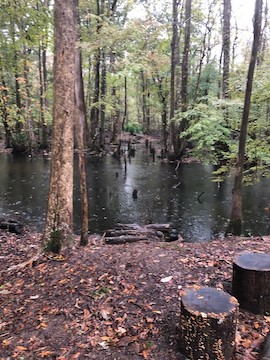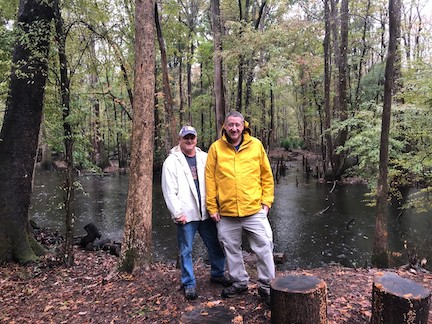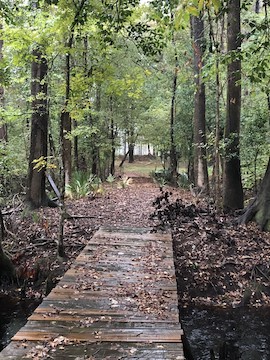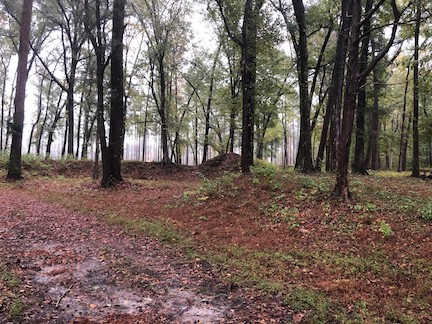Chasing Uncle Billy: Breaching the Line of the Salkahatchie River (part one)

(part one of two)
My friend and co-author Wade Sokolosky and I just spent the last three days chasing William T. Sherman’s march through South Carolina and part of North Carolina. Along the way, we both saw things we had never seen before. And we got wet. Really wet. We had pretty much two solid days of liquid sunshine on Friday and Saturday totaling about 1.5 inches of rain. It was cold and raw in the wind. But it was worth it.
The focus of our day on Friday was visiting the three sites along the initial Confederate line of defense in South Carolina, the Salkahatchie River. I must admit that while I knew that the Salkahatchie was largely a swamp, it really didn’t look much like I thought it would. The actual channels are quite narrow, but the swamp extends for more than a mile. The water is pitch black, and when it’s warmer, I’m certain that its occupants include water moccasins, alligators, and other interesting critters. Fortunately, when it’s 45 degrees, cold-blooded reptiles aren’t terribly interested in bothering visitors. We were just fine with that….

Our guides were Dr. Steve Wise, who resides in Beaufort and is the curator of the museum at the Marine Corps base at nearby Parris Island, and Dan Bell, who works for South Carolina’s state park system, and is responsible for the River’s Bridge site. We couldn’t have asked for two better or more knowledgeable guides. Thanks to both of them for their time and expertise.
A series of rivers crosses South Carolina on a diagonal bias. Those rivers provided the Confederates with opportunities to resist Sherman’s advance. Gen. P.G.T. Beauregard, who was an extremely able engineer, chose his positions well and wisely. The problem is that he had only about 8000 soldiers to man those lines. The command was a hodgepodge, consisting of Maj. Gen. Joseph Wheeler’s cavalry, soldiers assigned to Beauregard’s department under command of Maj. Gen. Lafayette McLaws, and some troops from the Army of Tennessee under Maj. Gen. Carter Stevenson. This meant that there would be little depth to the Confederate positions, since there were so few troops available to man them, and it also meant that Beauregard did not have the option of defending every crossing.

The first one that he chose was the line of the Salkahatchie River toward the southern part of the state. The impenetrable swamp meant that there were only three viable crossings, each with bridges: on the eastern end, Buford’s Bridge, River’s Bridge in the center, and Broxton’s Bridge on the western end. If Beauregard could bottle up Sherman at these crossing sites, he had a chance. Hence, extensive earthworks were dug to cover each bridge, artillery was placed, and troops assigned to defend them. Broxton’s Bridge, in particular, had impressive works. There was a large earthen fort dug there, manned by 12 pieces of artillery, and a lengthy line of defensive earthworks was also prepared, extending from the causeway that carried the road across the swamp and the river.
River’s Bridge and Buford’s Bridge also had defenses prepared. A large earthen line was dug on a bluff overlooking the River’s Bridge crossing site. The area around Buford’s Bridge was thickly forested and hence provided few opportunities for crossing other than at the bridge. Consequently, the Union high command elected to make its primary efforts at River’s Bridge and Broxton’s Bridge. The badly outnumbered Confederate defenders would have their hands full.
Beauregard planned well. But he did account for one thing: the fact that Sherman’s army would do some of the most remarkable work of any army in history in forcing its passage through South Carolina. Specifically, Sherman’s engineers and pioneers worked miracles in corduroying and building roads that enabled the Union army to make its way through what otherwise would have been impenetrable swamps. At the end of the campaign, an incredulous Gen. Joseph E. Johnston, who surrendered to Sherman at the end of April, declared, about Sherman’s army, “I made up my mind that there had been no such army since the days of Julius Caesar,” referring to Caesar’s crossing of the Alps. The work of Sherman’s engineers and pioneers made the impossible possible. And they set the stage for the breaching of the Salkahatchie River line.

(to be continued….)
Eric:
Glad to see you included Joe Johnston’s reference to Caesar in your post. The Low Country of South Carolina is a patchwork of swamps and bayous. Before Uncle Billie’s boys began marching through the mire, the area was thought to be impenetrable for an army.
I enjoyed this post. Looking forward to part 2.
Eric: Another nice contribution. As a direct descendant of a guy who served three years in the US Engineers Battalion, I appreciate the reference to the road building by Cump’s pioneers/engineers.
Thanks, John. The old saying goes, “Amateurs study tactics. Professionals study logistics.” While a rank amateur, I have always found logistics fascinating, and what Sherman’s engineers accomplished in South Carolina is nothing short of miraculous.
Dear Eric:
As I’m sure you’re aware, logistics (road/bridge building) played an important part in another great Army of Tennessee campaign – Grant’s ability to march most of his army along the soggy Louisiana side of the Mississippi River so he could south of Vicksburg.
John, I’m finding my research on the pontoon regiments within Sherman’s army group, the 58th Indiana and 1st Missouri Engineers, to be quite fascinating, I am knee-deep trying to find out as much as I can on the “Cumberland Canvas Pontoon Boats.” It fascinates me how the engineers from the Army of the Cumberland modified the existing 23′ ft boat frame so that it could be folded with hinges, which facilitated quicker assembly, and allowed transport using a standard Army issue wagon, verses a specifically designed one. Great stuff.